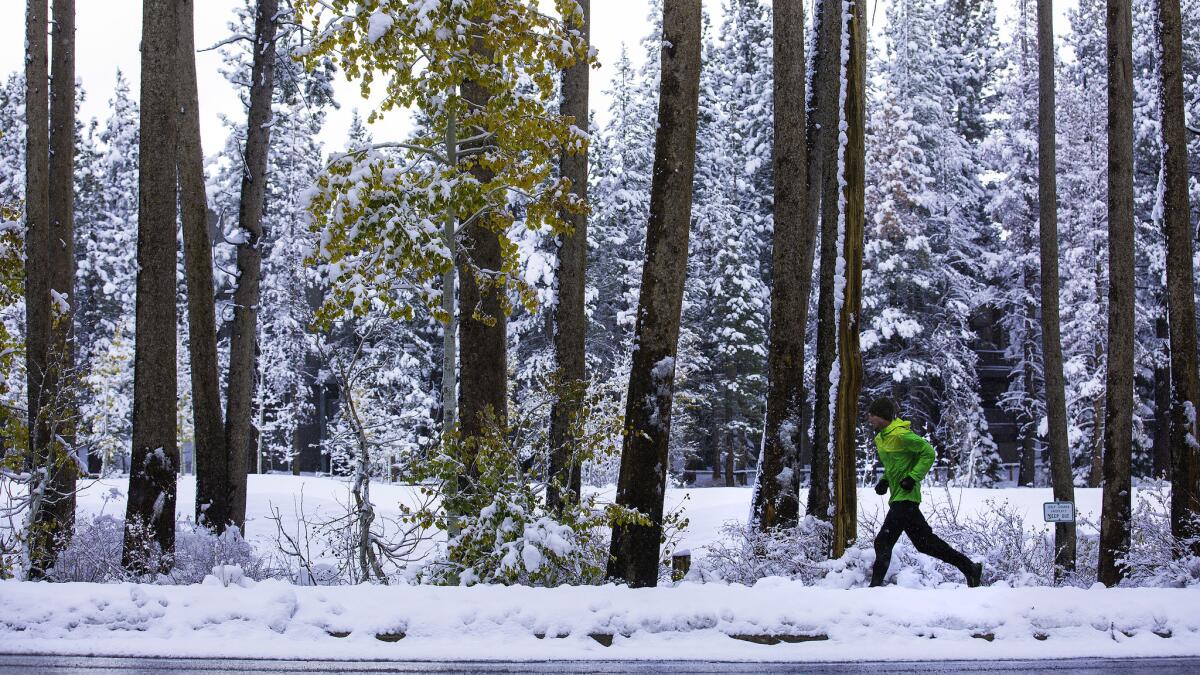California officials upbeat about snowpack, but long-range prospects are unknown

A man runs on a trail after a Sierra Nevada storm dropped nearly a foot of snow at Mammoth Mountain in November.
- Share via
Over the last several weeks, snowboarders and skiers alike have reveled in what seems to be bountiful Sierra Nevada snow.
All that powder has enabled even weary state water officials to express some optimism, a feeling buoyed Wednesday when surveyors took their first manual measurement of the Sierra snowpack and found more than 54 inches.
But for all of the excitement, the state’s broader drought outlook remains uncertain.
Although there was about twice as much water in the state’s snow as there was on the same day last year, and five times as much as the year before that, it still just amounts to an average total.
“Last year was so abysmally bad that even coming up to the average we have now looks good,” said Department of Water Resources spokesman Doug Carlson.
Snowpack is important because it melts during the spring and summer months and refills the state’s reservoirs. Officials say that in normal years the snowpack supplies about 30% of California’s water. They have also said that the state needs a snowpack equal to 150% of average by April 1 to have any chance at ending the drought.
On Wednesday, electronic readings from 99 stations throughout the Sierra Nevada showed that the snowpack statewide held 10.2 inches of “water equivalent” — or about 105% of average for the day.
The manual survey, taken at a single station about 90 miles east of Sacramento, was more promising but less telling. It found 54.7 inches of snow on the ground — 16 inches above average. The water held in that snow amounted to about 136% of normal for the site.
After taking the measurement and leaving a path of boot prints in his wake, Frank Gehrke, chief of the California Cooperative Snow Surveys Program, told a group of tightly bundled reporters that the snowpack was “encouraging, but still obviously not where we’d like to be.”
“The real critical thing is going to be … good solid production in terms of the rest of the season,” Gehrke said. “The problem we’ve had in past years is we start off OK, but then it shuts off.”
Because four years of drought have dried out the terrain, “a good part” of this year’s snowpack will soak into the ground before “we start to see it as runoff,” Gehrke said.
The state’s major reservoirs could use that runoff.
As of Wednesday, Lake Oroville — the State Water Project’s principal reservoir — held about 1 million acre feet of water, or about 47% of its historical average for Dec. 30. Lake Shasta — the Central Valley Project’s largest reservoir — was at 51% of its average.
Meanwhile, the cumulative amount of rain measured at eight important stations in the northern Sierra was about normal for the day.
“Obviously we had a great first quarter” of the water year, said Mark Gold, associate vice chancellor for environment and sustainability at UCLA. “But that’s after a four-year slump. We’ve got a long way to go to make up for such an enormous deficit.
“It’s just too early to get excited.”
Skiers and snowboarders, though, have been exactly that. The series of storms that began pounding the Sierra Nevada last week has resulted in a surge in business for ski resorts across the state, officials say.
Michael Berry, president of the National Ski Areas Assn., said resorts have posted an increase in visitors and have been able to open more terrain this season.
Member organizations “couldn’t be happier” with snow conditions, he said.
“It really is a night and day situation,” Berry said. “For skiers and riders, it’s the best skiing and riding that they’ve had in those four years in California.”
Indeed, Gehrke joked that although state officials care only about the water contained in the snow, the fresh powder was “great ... for skiing.”
Moving forward, he said it’s vital that the state avoid long stretches without snowfall.
Water officials plan to take as many as four more manual snow surveys by early May.
“We’ve got four to five months before the final tale is told,” Gehrke said.
Twitter: @ByMattStevens
taylor.goldenstein@latimes.com
Twitter: @taygoldenstein
ALSO
28 things to do to prepare for El Niño rains this season
Evacuees wait out historic floods still spreading through Midwest
Want to see winter in Yosemite? Check out these snowy photos -- and go now
More to Read
Sign up for Essential California
The most important California stories and recommendations in your inbox every morning.
You may occasionally receive promotional content from the Los Angeles Times.












